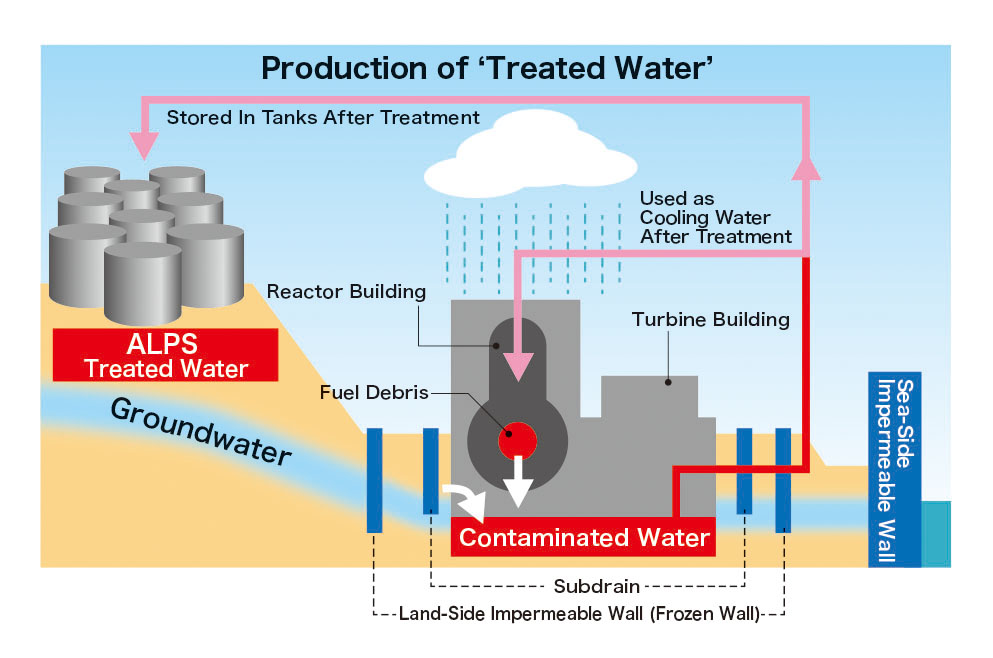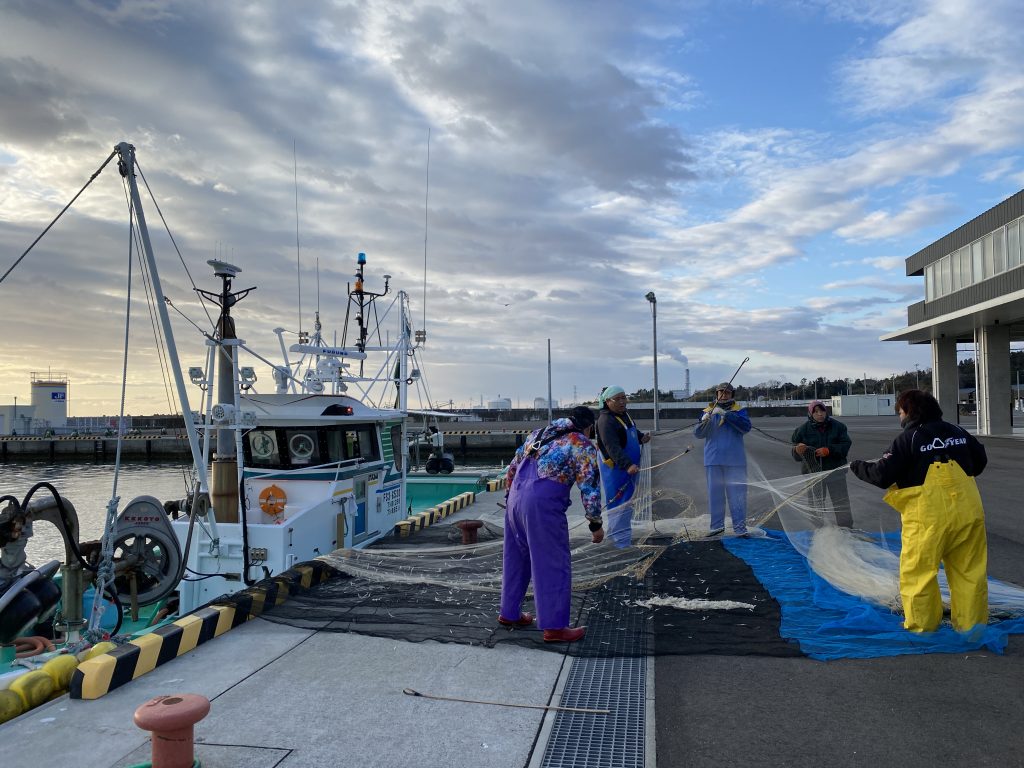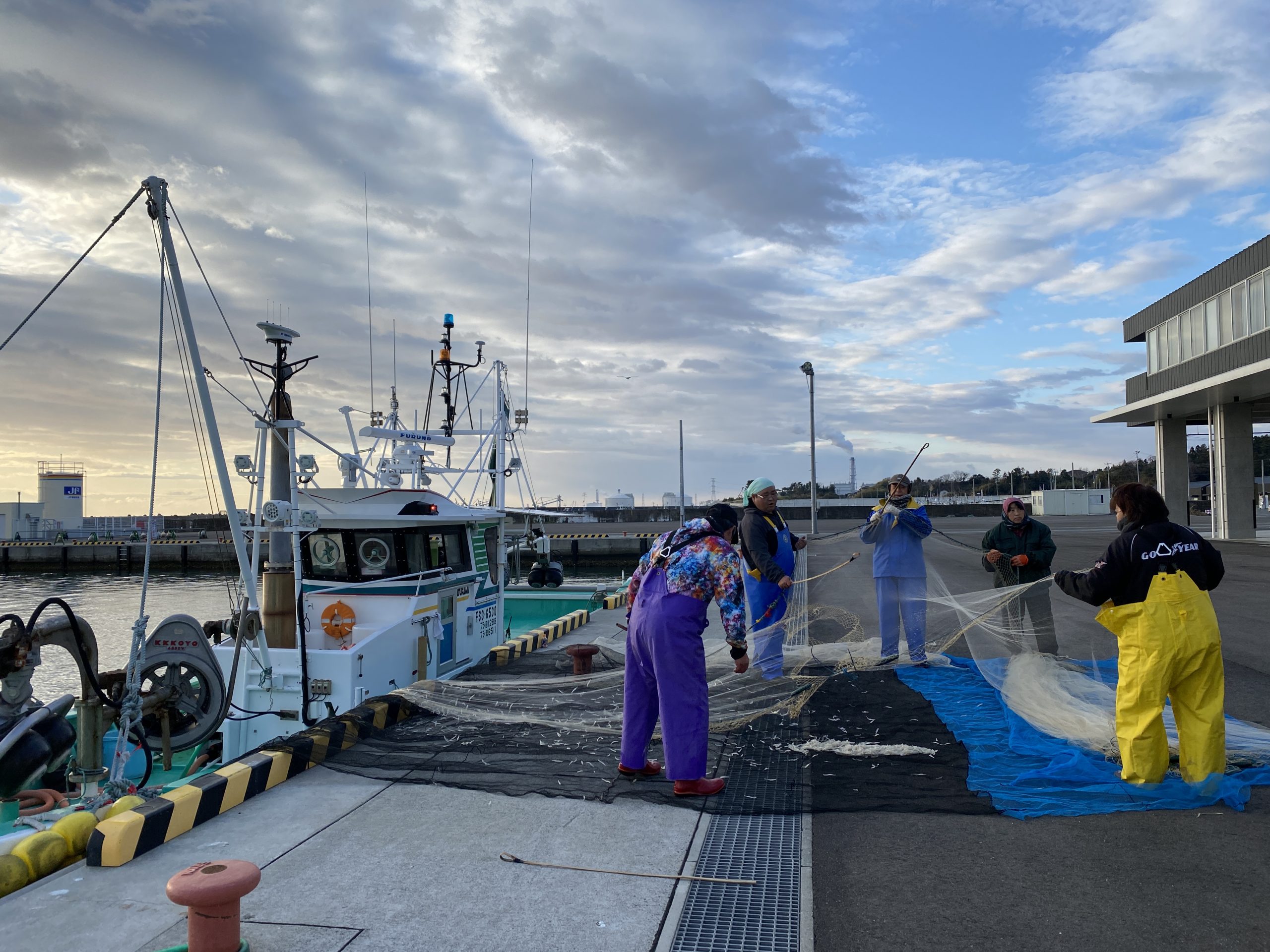The government was expected to make a decision in the summer of 2020 on the release of the contaminated water that continues to increase from the Fukushima Daiichi Nuclear Power Plant. However, as of January 2021, no decision has been made on how to dispose of the contaminated water due to opposition from many parties, including the fishing industry. TEPCO is now contemplating the possibility of adding more tanks.
The contaminated water which is at the center of this issue is water that has been processed by the so-called Advanced Liquid Processing System (ALPS, also described as a multi-nuclide removal system). The system treats a mix of cooling water from fuel debris as well as groundwater that flows into the reactor and turbine structures. At the time of writing, already more than 1.2 million cubic meters of treated water were being stored in approximately 1,000 tanks, as indicated in the diagram below.

The total amount of tritium is estimated to be approximately 860 trillion Bq, and about 80% of the water contained 62 radionuclides other than tritium, with notified concentration ratio sums[1] exceeding 1[2]. TEPCO has stated that if the water is to be released into the ocean, it will undergo secondary treatment to bring the levels below regulation standards. However, the total amount of radioactive materials currently in the tanks has not been indicated.
In February 2020, the ALPS Subcommittee, which had been studying the possible ways in which to handle the contaminated water, released a report stating that “releasing the contaminated water into the ocean or atmosphere is a realistic option.”
The Ministry of Economy, Trade, and Industry (METI) explained that tritium is released from nuclear power plants around the world and that it has little effect on human health. Although the energy content of tritium is extremely low, it has been noted that tritium can cause damage to DNA when it enters cells as an organically bound form, or when it decays and becomes helium, replacing the hydrogen that makes up DNA[3].
Opposition from the Fishing Communities
The Fukushima Prefectural Federation of Fishermen’s Cooperative Associations has repeatedly expressed its opposition, stating that they are “firmly opposed to releasing the water into the ocean and calling for strict land-based storage in tanks”. Fishing federations in neighboring Miyagi and Ibaraki prefectures have also expressed their opposition. On June 23, the National Federation of Fishermen’s Cooperatives unanimously adopted a special resolution[4]4 at its general meeting to “firmly oppose the release of contaminated water into the ocean.” Furthermore, on October 15, members from the Federation met with Mr. Kajiyama (Minister of Economy, Trade, and Industry), and Mr. Koizumi (Minister of the Environment) to submit a letter of request to oppose the release of water into the ocean.
Since the time immediately following the nuclear disaster, local fishermen have been deceived both intentionally and unintentionally regarding contaminated water. In the past, TEPCO announced the leakage of contaminated water after the fact. For these reasons, when the prefectural fishermen’s federation was forced to agree to the release of water from the underground water bypass and sub-drains (wells near the plant) into the ocean, they made TEPCO promise that it would not dispose of the ALPS treated water “without the understanding of all concerned parties”. If TEPCO were to release the contaminated water into the ocean, it would be a violation of that promise.
Voices of Residents Not Heard
It is not only the fishing communities who are opposed. In Fukushima Prefecture, 41 out of 59 municipal assemblies have passed memorandums or resolutions opposing or expressing caution regarding the release of the contaminated water into the ocean.
There is also strong opposition from overseas. On May 13, 2020, 23 environmental NGOs in Taiwan submitted an opinion to the Ministry of Economy, Trade, and Industry (METI), arguing that the release of contaminated water into the ocean is in violation of the London Convention, which prohibits the dumping of radioactive materials into the ocean. In addition, NGOs from South Korea, the Philippines, the United Kingdom, Austria, Australia, and the United States have also expressed their opposition.
On June 9, four UN Special Rapporteurs issued a joint statement expressing concern over the Japanese government’s hasty decision to release treated contaminated water into the ocean amid the pandemic “without providing time or opportunity for significant discussion.”
About a year and a half before the subcommittee report was released, when the subcommittee was still only halfway through discussions, METI held “explanatory and public hearings” on August 30 and 31, 2018, in Tomioka Town and Koriyama City in Fukushima Prefecture, and in Chiyoda Ward in Tokyo, in the form of a meeting hosted by the subcommittee secretariat. At the public hearings, people selected through an open call for public contributions stated their opinions, and 42 out of 44 were clearly opposed to release into the ocean. Many of them pointed out the dangers of releasing tritium into the environment and said that it should be stored long-term in tanks on land. These public hearings were widely reported by the media.
Since the subcommittee compiled its report, METI has not held any public briefings or public hearings regarding its contents. Instead, since April 2020, the ministry has held a total of seven “opportunities to hear opinions” from select local governments in Fukushima Prefecture and representatives of industry groups and local governments. The meetings were held at a time when the spread of the Novel Coronavirus was surging. They were extremely performative, with no audience, and were held via videoconference, with the vice ministers of the relevant ministries in attendance, and the heads of local governments and representatives of various organizations expressing their opinions one by one, with very little time for questions.
Of the 44 people who spoke, 43 were men. This is probably because in Japanese society, the heads of these organizations are relatively elderly men, and as a result, the voices of women and youth were not heard.
Even at these formal hearings, not only the Fukushima Prefectural Federation of Fishermen’s Cooperative Associations, but also the Fukushima Prefectural Forestry Cooperative Association and the Fukushima Prefectural Central Association of Agricultural Cooperatives expressed their opposition to oceanic and atmospheric release. In other words, all local primary industry organizations were opposed.
For the public, it was simply stated that comments from the public “would be accepted in writing,” in other words through the submission of public comments. The total number of public comments submitted was 4,011. Approximately 10% of those comments were disclosed after JNN requested information disclosure, but more than 70% were opinions opposing the release or calling for storage on land[5]. METI has stated that it will publicize the content of the public comments and the responses to them at the same time as it announces its decision on the disposal policy. Normally a policy decision is made after two-way exchange with the public is conducted. This is undemocratic.
The Alternative Proposal Goes Ignored
The technical subcommittee of the Citizens’ Commission on Nuclear Energy, a private think tank with many plant engineers participating, proposed a “large-scale tank storage plan” and a “mortar solidification plan” and submitted them to the Ministry of Economy, Trade, and Industry[6].
The large-scale tank storage proposal outlines a plan to build 100,000 m3 tanks with domed roofs and water-sealed vents. The plan proposes that a site be selected from either the planned site for Units 7 and 8, the spoil bank, or the hinterland of the site with the approval of the local community. It proposes that 20 tanks be constructed on a site of 800m x 800m and that by replacing existing tanks with larger ones, they will be able to store enough contaminated water for 48 years. Large-scale tanks have been used for oil storage and other purposes and have a proven track record. In addition, the dome-shaped tanks will eliminate the risk of rainwater contamination. The proposal for the large-scale tanks also includes the installation of a leakage containment barrier.

Source: Savannah River Remediation LLC (SRR)
The “mortar solidification plan” outlines a method to dispose of contaminated water as was used at the Savannah River Nuclear Facility in the U.S. The contaminated water is mixed with cement and sand and stored in a semi-subterranean environment. By solidifying the contaminated water, the risk of radioactive materials leaking into the ocean can be eliminated. However, due to the mixing of cement and sand, the volume efficiency is reduced to about one fourth. Yasuro Kawai, a former plant engineer at the Citizens’ Commission on Nuclear Energy, who compiled the proposal states that, “nevertheless, an 800m x 800m site, will enable us to store enough contaminated water in mortar to last for 18 years.”
Is There Really a Lack of Space?
Some have suggested that the north side of the site, which is currently being used as a spoil bank, could be used to expand the grounds of Fukushima Daiichi Nuclear Power Plant. The Ministry of Economy, Trade, and Industry (METI) is reluctant[7] to explore the idea of expanding the site, saying it would be difficult to gain the understanding of the local people. Recently, it was reported that the area where old empty tanks used to be located is available for use[8], and TEPCO is currently considering using this space to build additional tanks.
“Producing Electricity for Tokyo…”
According to a public opinion poll conducted by Asahi Shimbun and Fukushima Broadcasting Co. in late February 2020, 57% of people eligible to vote in Fukushima Prefecture said they were “opposed” to diluting the treated water and discharging it into the ocean. In addition, Fukushima’s local newspaper, Fukushima Minpo, stated, “Release of contaminated water beginning off of the coast of this prefecture or in our atmosphere, or release limited to our prefecture will lead to further harmful rumors and is absolutely unacceptable and should not be permitted.” (December 27, 2019).
FoE Japan visited the fishing ports of Onahama in Iwaki City, and Shinchi Town, and had the opportunity to hear the opinions of the fishermen. They have a strong sense of awareness regarding this potential further crisis. Many voiced their opinions that they are adamantly against the release of even more radioactive materials into the ocean at a time when they are finally recovering from the devastation caused by the nuclear disaster. They also voiced concerns of the long-term effects and expressed anger and distrust in the fact that they had voiced their opinions of protest multiple times and have not been heard.
“The nuclear power plants used to produce electricity for Tokyo’s consumption caused this catastrophe and is harming the fishing industry. If the contaminated water is as safe as they claim it to be, then it should be released in Tokyo.” Multiple people voiced similar opinions.

They also stated, “This is not just a problem for fishermen. It is an issue for the entire nation.”
What Needs to Be Done to Arrive at a Decision
In principle, radioactive materials should be managed centrally and should not be dispersed into the environment. The contaminated water should not be discharged into the ocean but should be stored on land either in large tanks, via solidified mortar, or by expanding the site grounds.
The government still has a lot of work to do before it can make a decision. First, the government and TEPCO should indicate the radionuclides and the total amount of each radionuclide contained in the water currently stored in the tanks. They should also examine the alternatives and the risks of releasing the water and present those results. Furthermore, a public hearing and briefing session should be held in which anyone can participate and express their opinions, and the government and TEPCO should provide explanations and answer any questions.
Amplifying the Voices of Fishing communities
“What is ALPS-treated contaminated water?”, “What’s in it?”, “Is tritium safe?”, “Is there really no choice but to dump it into the ocean?” –In order to provide answers to these questions, FoE Japan created an easy-to-understand Q&A and has distributed it widely. FoE Japan has also partnered with other grassroots organizations to conduct study sessions in Iwaki City and Koriyama City.
In February 2020, FoE Japan interviewed fishermen at Onahama Fishing Port in Iwaki City and Tsurishinohama Fishing Port in Shinchi Town to create a 12-minute video (“Fishermen of Fukushima”).
In addition, FoE Japan invited fishermen from Iwaki and held a “Listening to Fishermen’s Stories” session at the Congressional Office Building. FoE Japan helped to deliver the voices of fishermen to the Ministry of Economy, Trade, and Industry and to members of the Diet.
In May, FoE Japan conducted a survey of fishery cooperatives in the six prefectures of Iwate, Miyagi, Fukushima, Ibaraki, Chiba, and Tokyo, revealing that fisherman outside of Fukushima are also opposed to the release of treated contaminated water into the ocean. FoE Japan also held a series of five online public comment seminars to encourage people to voice their opinions.
(“Fukushima Today and Japan’s Energy Future 2021”
The original article was written in March 2021)
[1] ”The notified concentration ratio sum” is the sum of the ratio of the concentration of each nuclide to the notified concentration limit of that nuclide. Emission standards are set to be less than 1.
[2] November 18, 2019 Document published by TEPCO
[3] Kamizawa Chihiro (May 2013) “Contaminated Tritiated Water from Fukushima Daiichi Nuclear Power Plant” Kagaku
[4] The National Federation of Fishermen’s Cooperatives Press Release “Special Resolution to Firmly Oppose the Release of Contaminated Water into the Ocean” (June 23, 2020)
[5] TBS News “70% of ‘citizen’s opinion’ stated that they were ‘opposed to the release into the ocean’ of contaminated water from the nuclear power plant.” (October 16, 2020)
[6] Citizens’ Commission on Nuclear Energy “Views on how to deal with ALPS treated water” (October 3 2019)
[7] Documents from 16th Subcommittee meeting
[8] Kahoku Shimpo “Unused area in Fukushima Daiichi can store more tanks, TEPCO has not shown any plans to use it”(December 18 2020)

